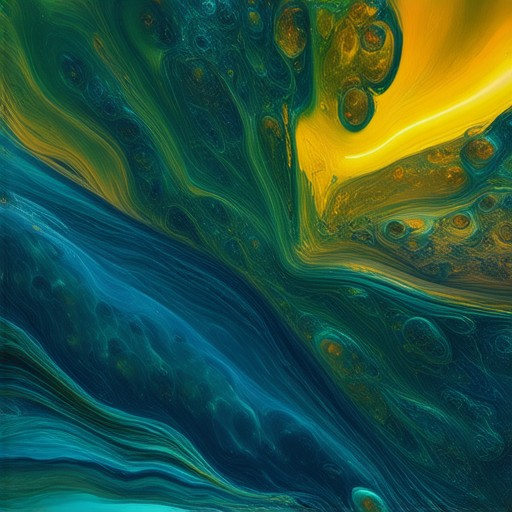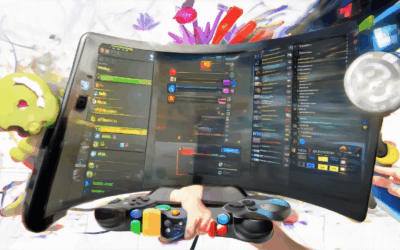Understanding Procedural Generation in Games
Procedural generation has become a cornerstone of modern gaming experiences, revolutionizing how games are designed and played. This innovative approach allows games to dynamically generate content, levels, and environments based on algorithms, offering unique experiences each time players interact with the game. From vast, procedurally generated open worlds to intricate procedural animations, this technology has redefined how developers create immersive and unpredictable gameplay.
In this article, we delve into the intricacies of procedural generation in games, exploring its applications, underlying technologies, and the impact it has had on the gaming industry. Whether you’re curious about how Minecraft generates its landscapes or interested in learning about the latest trends in procedural generation, this guide will provide you with a comprehensive overview of one of the most exciting developments in game development.
We’ll examine how procedural generation enhances gameplay through dynamic content creation, discuss the algorithms and tools that make it possible, and highlight the role of artificial intelligence in shaping the future of procedural generation. By the end of this article, you’ll have a deeper appreciation for how procedural generation transforms simple rules into complex, engaging experiences that keep players coming back for more.

What is Procedural Generation in Games?
Procedural generation is a method of creating game content, levels, or environments through algorithms that follow specific rules rather than being pre-designed. This approach allows for dynamic, customizable, and often unpredictable outcomes, enhancing replayability and reducing reliance on manual design.
Why is Procedural Generation Important?
- Efficiency : Reduces the time and effort required to create vast amounts of content manually.
- Customization : Allows players to influence or customize their experience through choices or actions.
- Variety : Ensures that each playthrough feels unique, increasing engagement and replay value.
Key Applications in Game Development
- World Generation :
- Terrain : Procedural terrain generation creates diverse landscapes, from vast plains to mountain ranges.
- Structures : Buildings, caves, and other environmental features are generated algorithmically.
-
Resources : Procedural generation of resources like ore, wood, and water distribution adds depth to exploration.
-
Enemy Spawning :
-
Monsters and enemies are placed strategically based on difficulty level, player location, and time of day.
-
Story Creation :
-
Narrative elements like quests, NPCs, and dialogue can be procedurally generated to create branching storylines.
-
Player Progression :
- Skills, abilities, and equipment are assigned or unlocked through procedural systems, ensuring varied character builds.
Benefits Beyond Gameplay
- Performance Optimization : Reduces memory usage and processing power needed for complex designs.
- Complexity Handling : Manages intricate systems that would be difficult to design manually.
Challenges
- Balance : Ensuring fairness and challenge without making the game feel too random or predictable.
- Consistency : Maintaining a cohesive experience despite procedural elements.
Future Trends
Procedural generation is expected to become more sophisticated, incorporating AI and machine learning for real-time generation of dynamic environments.
For more resources on implementing procedural generation in your indie game development project, visit our Indie Dev Games hub.
Minecraft Procedural Generation
Minecraft employs procedural generation to create its environments. This process involves generating terrain, structures, and other elements algorithmically, often using random seeds to ensure variability. The game’s world is not predefined but instead created dynamically based on player actions and server settings.
Key aspects of procedural generation in Minecraft include:
- Biome distribution: The game uses a seed value to determine the placement of biomes, ensuring each world feels unique.
- Dungeon generation: Dungeons are created procedurally, with varying layouts and hidden rooms.
- Structure placement: Villages, temples, and other structures are positioned differently each time the world is generated.
- Item and resource placement: Resources and treasure are placed randomly, enhancing exploration.
This approach allows for endless possibilities, making each Minecraft experience feel fresh and unique.

What Games Use Procedural Animation?
Procedural animation refers to the generation of visual or behavioral content in video games through algorithms and rules, rather than pre-defining every frame or movement. This approach allows for dynamic, unpredictable outcomes and efficient resource usage. Below is a list of notable games that employ procedural animation:
Indie Games Leading the Way
Many independent (indie) developers have embraced procedural animation due to its flexibility and cost-effectiveness. Here are some standout examples:
- ** Indie Dev Games
-
Our platform highlights numerous indie titles that utilize procedural animation, showcasing the diversity of creativity and technical prowess in the indie sector.
-
Celeste (Devolver Digital)
-
Celeste employs procedural animation to create fluid, character-driven narratives and environments, enhancing the player’s emotional connection to the story.
-
Hyper Light Drifter (Asteroid City / Whatnot)
-
This game uses procedural animation to generate vibrant, procedurally generated worlds that feel alive and unique with each playthrough.
-
The Stanley Parable (Curious Fish Studio)
-
Known for its interactive narrative, The Stanley Parable uses procedural animation to create branching storylines and reactive environments.
-
Dandelin Dynamics * (Dandelin Games)
- Specializing in procedural animation, Dandelin Games creates games like Dandelin Drift where particles and objects move in unpredictable, algorithmically generated patterns.
AAA Titles Experimenting with Procedural Techniques
While more common in indie circles, some AAA titles are beginning to integrate procedural animation for unique effects:
- Elden Ring (FromSoftware)
-
FromSoftware’s Elden Ring features procedural animations for enemy movements and environmental interactions, contributing to its immersive open-world experience.
-
The Legend of Zelda: Breath of the Wild (Nintendo)
-
While not fully procedural, Breath of the Wild uses dynamic animations generated on-the-fly to simulate exploration and combat.
-
Red Dead Redemption 2 (Rockstar Games)
-
Rockstar’s use of procedural animation in Red Dead Redemption 2 creates realistic interactions with the environment and characters, enhancing immersion.
-
Horizon Zero Dawn ( Guerrilla Games)
-
Guerrilla Games implemented procedural animation to bring robotic creatures to life in Horizon Zero Dawn , adding depth to the game’s world.
-
Assassin’s Creed Valhalla (Ubisoft)
- Ubisoft employs procedural animation techniques to generate historical battles and crowd interactions, making the Viking raids in Valhalla feel epic and chaotic.
Experimental and Niche Titles
-
Frasier (Rain World Games)
- Frasier uses procedural animation to simulate the behavior of animals in a post-apocalyptic setting, creating a lifelike ecosystem.
-
Oats Studios: Volume 1 (Oats)
- Oats’ Volume 1 showcases procedural animation in its surreal, abstract gameplay, pushing the boundaries of traditional game design.
-
Procedural Planet Generator (Noowans)
- As the name suggests, this game generates planets and civilizations procedurally, allowing players to explore and shape unique worlds.
-
Botanicula (Akylropolis)
- Botanicula uses procedural animation to create organic, plant-based environments that react dynamically to player actions.
-
The Evolution (Evolvension)
- A minimalist, procedural animation-driven puzzle game where players evolve geometric shapes through simple rules.
Conclusion
Procedural animation is revolutionizing game development by enabling creative freedom and efficiency. The listed games demonstrate the versatility of this technique across various genres, from indie gems to AAA blockbusters. Explore Indie Dev Games for more insights and resources on procedural animation and game development.

Best Game Engines for Procedural Generation
Procedural generation is a powerful technique in game development that allows for the automatic creation of game content, such as levels, assets, and environments, based on algorithms. Here are some of the best game engines for implementing procedural generation:
- Unity : Known for its flexibility and ease of use, Unity offers built-in tools for procedural generation, including procedural meshes and textures. It’s widely used in the indie dev community and supports plugins for extending procedural capabilities.
- Unreal Engine : As a high-end option, Unreal Engine provides advanced tools for procedural generation, such as procedural materials for generating textures. It’s favored by larger studios but can also be accessed by indie developers.
- Godot : An open-source engine popular for 2D games, Godot supports procedural generation through its tilemap and map generation systems. It’s a great choice for smaller projects or those focused on 2D graphics.
- GameMaker : Known for its user-friendly interface, GameMaker has improved its procedural generation capabilities over recent updates. It’s an excellent choice for developers looking for a no-code approach to game development.
- Construct 3 : With its visual scripting system, Construct 3 allows for easy setup of procedural generation, particularly for terrain and environment creation. It’s known for its intuitive design and plugin support.
- Spring Engine : An open-source engine designed specifically for procedural generation, Spring Engine uses procedural modeling to create complex game environments. It’s ideal for projects requiring detailed, algorithmically generated content.
- Aseprite : While primarily a pixel art tool, Aseprite offers features for procedural generation of tiles and patterns, making it a valuable addition to 2D game development workflows.
When choosing a game engine, consider factors like your project scale, budget, and specific procedural generation needs. Each engine has unique strengths, whether you’re working on 2D or 3D projects, or need simple randomness versus complex landscape generation.
Can Unreal Engine Do Procedural Generation?
Yes, Unreal Engine supports procedural generation, a powerful technique that enables the automatic creation of complex and diverse content. This capability is particularly useful in game development, allowing for efficient content generation that can adapt to various needs.
Procedural Content Generation in Unreal Engine
Unreal Engine offers robust tools for procedural generation through its Procedural Content Generation (PCG) Framework , introduced in Unreal Engine 5. This framework provides developers with the ability to create and manage procedural content, enabling dynamic and varied environments.
Key Features of Unreal Engine’s PCG:
- Terrain Generation : Automatically generate landscapes and terrains, reducing manual effort in level design.
- Texture Synthesis : Create unique textures and materials based on procedural algorithms.
- Lighting Automation : Procedural generation of lighting setups, ensuring realistic and immersive environments.
- Character Creation : Generate NPC behaviors and appearances using procedural methods.
Benefits of Using Procedural Generation in Unreal Engine
- Efficiency : Streamline content creation processes, allowing developers to focus on design rather than manual labor.
- Customization : Tailor procedural outputs to match specific project requirements.
- Scalability : Handle large-scale environments with ease, as procedural systems can generate content on demand.
Use Cases for Procedural Generation in Unreal Engine
- Game Levels : Quickly prototype and iterate on game levels and environments.
- Environmental Design : Generate diverse and detailed world-building elements efficiently.
- Asset Creation : Automate the production of textures, models, and other assets.
Resources for Learning More
For developers looking to leverage these capabilities, the Procedural Content Generation Framework on Unreal Engine 5 is a valuable resource. It provides detailed documentation and tools to get started with procedural generation in your projects.
Learn More About Procedural Content Generation
By utilizing Unreal Engine’s procedural generation tools, developers can unlock new creative possibilities and streamline their workflow, ensuring high-quality content generation for their projects.

What is the 1 Game Engine?
The term “1 game engine” could refer to various platforms depending on the context, but it generally refers to a tool used by developers to create video games. Below is a breakdown of some of the most popular and widely-used game engines:
- Unity – Known for its versatility and ease of use, Unity is a popular choice among indie developers and large studios alike. It supports multiple platforms and offers robust features for 3D and 2D game development.
- Unreal Engine – Primarily known for its high-end 3D capabilities, Unreal Engine is often used for creating AAA games and immersive virtual reality experiences. It provides advanced rendering and physics tools.
- Godot – A free and open-source engine, Godot is popular among independent developers due to its efficient workflow and cross-platform support. It is known for its intuitive scripting language and extensive documentation.
- Blender – While primarily a 3D modeling and animation tool, Blender has grown into a game engine with a strong following. It offers a flexible pipeline for creating games and interactive experiences.
Each of these engines has its strengths, catering to different types of developers and project requirements. Whether you’re working on a small indie project or a large-scale commercial game, there’s likely an engine that fits your needs. For more information on these engines and to explore resources for game development, visit our Indie Dev Games Hub .
Conclusion: The best game engine depends on your specific needs, whether it’s for 3D, 2D, or multiplayer online games. Tools like Unity, Unreal Engine, and Godot provide powerful frameworks for creating engaging experiences across various platforms.




0 Comments